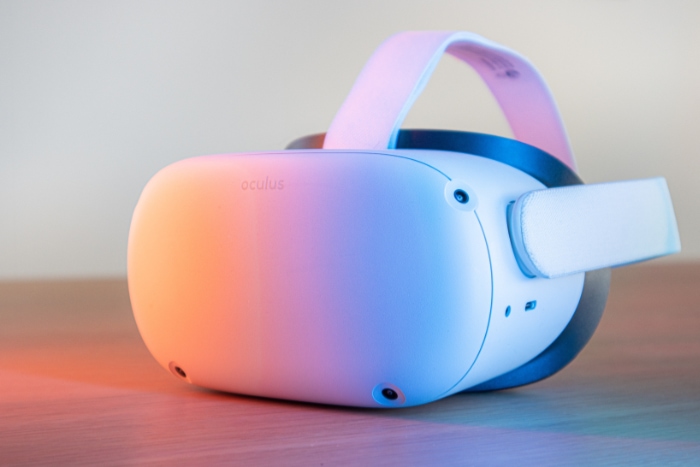Virtual Desktop vs. Air Link: Is the Paid App Worth It?

Cutting the cord redefined virtual reality by eliminating the fear of tripping over cables during intense gameplay. For Meta Quest owners, streaming high-fidelity PC titles wirelessly narrows down to two primary contenders: the integrated Air Link and the highly praised Virtual Desktop.
While Air Link provides a native solution directly from Meta at no cost, Virtual Desktop requires a purchase but claims to offer better stability and a richer feature set.
The choice between a free official tool and a paid third-party application is rarely straightforward.
Performance and Visual Fidelity
Wireless VR streaming relies heavily on how data travels from your PC to the headset. Both Air Link and Virtual Desktop aim to compress this data efficiently, but they prioritize different aspects of the transmission.
Users often notice subtle differences in how games feel and look, depending on which software handles the encoding.
Latency and Stability
The most critical metric in wireless VR is “motion-to-photon” latency. This term refers to the time it takes for your physical movement to be reflected on the headset screen.
High latency results in a “floaty” feeling or motion sickness. In ideal network conditions, both solutions perform admirably.
However, Virtual Desktop typically maintains a reputation for tighter consistency. It often recovers faster from network hiccups, smoothing out micro-stutters that might break immersion.
Air Link has improved significantly since its launch. It offers a solid experience for most users.
Yet, it can be prone to occasional latency spikes where the image momentarily freezes or lags behind movement. Virtual Desktop tends to manage these fluctuations more gracefully.
The software seems to prioritize maintaining a steady frame rate, which helps keep the experience comfortable even when the Wi-Fi signal encounters minor interference.
Bitrate and Image Compression
Bitrate determines the amount of data sent per second. A higher bitrate generally means less visible compression artifacts, such as blocky shadows or blurry textures.
Air Link allows users to push the bitrate incredibly high, sometimes upwards of 200 Mbps or even higher with modifications. This capability is excellent for users with high-end routers who want the sharpest possible image in complex scenes.
Virtual Desktop often operates at lower default bitrates but utilizes highly efficient encoding. The developer has tuned the software to deliver a crisp image without requiring as much raw bandwidth.
This efficiency means that a game might look clearer on Virtual Desktop at 80 Mbps than it does on Air Link at the same setting. For users with older routers or congested networks, this efficient handling of data often results in a better-looking image.
Visual Quality and Advanced Codecs
Beyond raw data speed, the method of compressing the image matters. Users frequently describe the default color profile of Air Link as slightly “washed out” or gray-toned.
It aims for a neutral look that sometimes lacks depth. Virtual Desktop offers options to boost color vibrancy and adjust gamma directly within the headset, producing a punchier, more contrast-heavy image that many gamers prefer.
Hardware compatibility also plays a role here. Virtual Desktop was quick to adopt modern codecs like HEVC 10-bit and AV1.
These advanced compression standards significantly reduce “color banding,” which is the ugly stair-step effect seen in gradients like a dark sky or fog. Owners of newer graphics cards and headsets, such as the Quest 3, can leverage AV1 in Virtual Desktop to get superior visual fidelity that Air Link sometimes struggles to match without extensive tweaking.
Setup and User Experience (UX)

While performance statistics are important, the daily experience of launching a game defines how much you enjoy your hardware. One solution offers a native, integrated path, while the other requires a separate purchase and installation but promises a more streamlined workflow.
Initial Configuration and Connectivity
Setting up Air Link requires the Meta Quest Link app installed on your PC. You must enable the feature within the PC software settings and then pair the headset via a toggle inside the Quest's quick settings menu.
Because it is built into the operating system, it feels like a natural extension of the headset. However, updates to the main Quest OS can sometimes reset these settings or cause handshake issues between the PC and the device.
Virtual Desktop follows a traditional app model. You purchase the app on the Quest store and install a free “Streamer” companion app on your PC.
The connection process involves entering your username into the PC streamer. Once done, the headset sees the PC immediately upon launching the app.
There are no toggles to hunt for in system menus; you simply open the application, and your computer is ready to connect.
Interface and Game Launching
Once connected, Air Link drops you into the Oculus Dash, a gray, curved interface floating in a white void or a virtual home environment. From here, you can access your desktop monitors or launch titles from the Oculus library.
Accessing SteamVR requires launching it as a separate application from within this dash, which adds an extra layer between you and your game.
Virtual Desktop takes a more consolidated approach. It features a dedicated “Games” tab that scans your computer for both Oculus and SteamVR titles.
This creates a single, unified library. You do not need to launch SteamVR manually; you simply click the game poster in the Virtual Desktop menu.
The software handles the necessary backend switching automatically. This creates a frictionless path to gameplay that avoids the clunky interaction of managing multiple windows in VR.
Reliability and Ease of Use
Air Link is an official feature, but it is prone to the idiosyncrasies of the Meta ecosystem. A driver update or a new headset firmware version can occasionally break connectivity, forcing users to troubleshoot via forums or support tickets.
Common fixes involve restarting the Oculus service on the PC or toggling beta channels.
In contrast, Virtual Desktop is often described as a “plug-and-play” solution. The developer releases frequent updates that address bugs rapidly.
For users with less-than-perfect network setups, the app provides clear feedback on connection quality. If performance drops, it is usually easier to diagnose the bottleneck within Virtual Desktop than to decipher the generic error messages sometimes presented by the native software.
Exclusive Features and Customization

The difference between the two contenders widens when looking at the tools they provide to power users. One focuses on seamless integration with the platform's social features, while the other acts as a comprehensive utility belt for VR enthusiasts.
Virtual Desktop Added Value
Virtual Desktop is more than just a streaming tool; it is a suite of utilities. One of its most popular features is the “Performance Overlay.”
When enabled, this displays a detailed breakdown of latency, network speed, and encoding times directly over your game. This allows users to pinpoint exactly why a game might be stuttering.
Additionally, the app includes “Synchronous Spacewarp” (SSW). This feature generates artificial frames to smooth out gameplay when your PC cannot maintain the target frame rate.
It allows lower-end PCs to play demanding titles more comfortably. The app also supports high-quality passthrough streaming, allowing you to see your physical room while playing PC games, and offers various virtual environments, such as a movie theater or a personal apartment, for consuming standard desktop content.
Air Link Native Integration
Air Link's primary advantage lies in its status as a first-party tool. It integrates fully with the Oculus PC dashboard.
This means you have immediate access to Oculus Parties and social features without switching apps. If you primarily play games from the Rift store and use Meta's social systems, Air Link keeps you within that walled garden seamlessly.
For power users, Air Link relies on the “Oculus Debug Tool,” a hidden executable found in the installation folders. This tool allows for granular changes, such as forcing specific bitrates or disabling features like Asynchronous Spacewarp.
However, these settings are not accessible inside the headset. You must take off the device and change them on your PC monitor, which interrupts the flow of usage.
Level of User Control
Virtual Desktop exposes almost all necessary settings directly within the VR interface. You can adjust gamma, brightness, bitrate, streaming codec, and microphone passthrough using a menu that appears with a button press.
This immediate control allows users to tweak their experience on the fly based on the game they are playing.
Air Link takes a more automated approach. It defaults to a dynamic bitrate that adjusts based on network health.
While this is good for beginners, it can be frustrating for users who want to lock in a specific quality level. Air Link assumes it knows what is best for the connection, whereas Virtual Desktop trusts the user to make the right adjustments for their specific hardware and visual preferences.
Compatibility and Hardware Requirements

The software you choose acts as the bridge between your computer and your headset, but the stability of that bridge depends heavily on the hardware supporting it. While both Air Link and Virtual Desktop facilitate wireless play, they handle game libraries and system resources differently.
These distinctions often determine which solution offers a smoother experience depending on whether you are playing a title purchased on Steam or one from the Meta Rift store.
Managing Game Libraries and Runtimes
How each application handles different game libraries significantly impacts performance. Air Link is built natively for the Oculus ecosystem.
When you launch a game from the Rift store, it runs directly through the Oculus SDK without any middleman. This ensures maximum compatibility and minimal overhead for those specific titles.
However, running SteamVR games via Air Link can sometimes feel clumsy. You typically have to load the Oculus interface first, then launch SteamVR, creating a “double layer” of software that can occasionally drag down performance.
Virtual Desktop handles this differently. It has a dedicated “Games” tab that aggregates titles from both the Oculus and Steam libraries into a single menu.
More importantly, it has optimized how it communicates with SteamVR. By bypassing some of the Oculus dashboard overhead, Virtual Desktop often provides a leaner, more direct pipeline for Steam games.
For users who strictly play on Steam, this often results in slightly better frame timings and fewer conflicts between the two varying software layers.
Hardware and Network Essentials
Regardless of which software you choose, the physical requirements remain steep. Both applications demand a VR-ready PC, generally requiring a modern mid-range GPU (like an NVIDIA RTX 3060 or better) to encode video streams in real-time without introducing lag.
The CPU is also vital, as it handles the game logic and the network transmission simultaneously. If your PC struggles to run a game on a monitor, streaming it to a headset will only compound the performance issues.
The most common point of failure, however, is the network setup. A standard ISP-provided router is rarely sufficient for a good experience.
Both Air Link and Virtual Desktop thrive on a dedicated Wi-Fi 6 or Wi-Fi 6E router. Ideally, the PC must be connected to the router via an Ethernet cable, and the router should be in the same room as the player to ensure a “line-of-sight” connection. While Virtual Desktop is often praised for handling network jitters better than Air Link, neither app can perform miracles if the Wi-Fi signal is weak or congested by other devices in the home.
Choosing the Right Tool for the Job
Air Link is generally the superior choice for games native to the Oculus Rift platform. Titles like Lone Echo or Asgard’s Wrath were built with the Oculus SDK in mind, and running them through the native Air Link interface usually guarantees the intended visual experience and controller mapping.
It eliminates the compatibility layers that third-party apps sometimes struggle with.
Conversely, Virtual Desktop excels as a general-purpose tool. It is often the better option for heavy SteamVR users, as well as those who use their headset for productivity.
Its ability to stream the Windows desktop crisply makes it ideal for watching movies, browsing the web, or working on large virtual monitors. Furthermore, its reliability makes it an excellent backup; if a driver update breaks Air Link, having Virtual Desktop installed ensures you are not locked out of your PC VR library.
Cost vs. Value

Deciding between a free, integrated feature and a paid third-party app ultimately comes down to where you place value: on saving money or on saving time. Air Link and Virtual Desktop are not mutually exclusive, but they represent different philosophies regarding user experience and control.
The Case for Air Link
For many users, Air Link is perfectly sufficient. It is built directly into the headset, requires no extra financial outlay, and offers a competent wireless experience.
If your network setup is optimal and you primarily stick to the Meta ecosystem, you may never feel the need for an alternative. It serves as an excellent starting point for anyone new to PC VR.
It allows you to test your hardware capabilities and network strength without spending a dime. For casual gamers who jump into VR occasionally, the friction of its interface is a minor trade-off for the zero-dollar price tag.
Justifying the Price of Virtual Desktop
Virtual Desktop positions itself as a premium tool for enthusiasts. The $20 asking price is effectively a payment for convenience, stability, and advanced features.
The software is frequently updated to support new headset features long before they are officially adopted by Meta. Features like the detailed performance overlay, simpler SteamVR integration, and superior color grading options transform the experience from “functional” to “enjoyable.”
Many users find that the time saved troubleshooting connection drops or tweaking obscure settings pays for the app within the first week of use. It is a “quality of life” upgrade that removes many of the headaches associated with wireless streaming.
Final Recommendations
The wisest approach for a new user is to start with Air Link. Since it is already installed, use it to benchmark your PC and router.
If you can play your favorite games without noticeable lag or stutter, you have saved yourself money. However, if you experience micro-stutters, find the colors washed out, or struggle with the SteamVR interface, Virtual Desktop is a worthwhile investment.
It is widely considered an essential utility for the serious PC VR gamer, acting as both a performance booster and a reliable safety net when the native software falls short.
Conclusion
Wireless PC VR has transformed from an experimental feature into a standard expectation for Quest owners. The existence of two powerful streaming solutions benefits the entire user base, as competition drives both stability and innovation.
Air Link stands as a formidable baseline. It is a technical achievement that ensures every user can access their PC library the moment they unbox their headset.
For those who play casually or primarily stick to the Meta ecosystem, it provides a completely viable experience without any financial barrier.
However, Virtual Desktop consistently proves that a paid application can offer value beyond just basic functionality. It addresses the friction points that often plague wireless streaming, offering a level of polish, visual fidelity, and reliability that the native software struggles to match.
While Air Link is a capable entry point, Virtual Desktop remains the enthusiast’s choice. It is an investment in a seamless, frustration-free experience that lets you focus less on network settings and more on the game itself.


